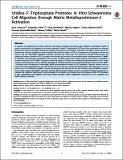Por favor, use este identificador para citar o enlazar a este item:
http://hdl.handle.net/10261/124938COMPARTIR / EXPORTAR:
 SHARE SHARE
 CORE
BASE CORE
BASE
|
|
| Visualizar otros formatos: MARC | Dublin Core | RDF | ORE | MODS | METS | DIDL | DATACITE | |

| Título: | Uridine 5′-triphosphate promotes in vitro Schwannoma cell migration through matrix metalloproteinase-2 activation |
Autor: | Lamarca, Aloa; Gella, Alejandro; Martiáñez, Tània; Segura, Mònica; Figueiro-Silva, Joana CSIC; Grijota Martínez, María del Carmen CSIC ORCID; Trullas, Ramón CSIC ORCID; Casals, Núria | Fecha de publicación: | 6-jun-2014 | Editor: | Public Library of Science | Citación: | PLoS ONE 9(6): e98998 (2014) | Resumen: | In response to peripheral nerve injury, Schwann cells adopt a migratory phenotype and modify the extracellular matrix to make it permissive for cell migration and axonal re-growth. Uridine 5′-triphosphate (UTP) and other nucleotides are released during nerve injury and activate purinergic receptors expressed on the Schwann cell surface, but little is known about the involvement of purine signalling in wound healing. We studied the effect of UTP on Schwannoma cell migration and wound closure and the intracellular signaling pathways involved. We found that UTP treatment induced Schwannoma cell migration through activation of P2Y2 receptors and through the increase of extracellular matrix metalloproteinase-2 (MMP-2) activation and expression. Knockdown P2Y2 receptor or MMP-2 expression greatly reduced wound closure and MMP-2 activation induced by UTP. MMP-2 activation evoked by injury or UTP was also mediated by phosphorylation of all 3 major mitogen-activated protein kinases (MAPKs): JNK, ERK1/2, and p38. Inhibition of these MAPK pathways decreased both MMP-2 activation and cell migration. Interestingly, MAPK phosphorylation evoked by UTP exhibited a biphasic pattern, with an early transient phosphorylation 5 min after treatment, and a late and sustained phosphorylation that appeared at 6 h and lasted up to 24 h. Inhibition of MMP-2 activity selectively blocked the late, but not the transient, phase of MAPK activation. These results suggest that MMP-2 activation and late MAPK phosphorylation are part of a positive feedback mechanism to maintain the migratory phenotype for wound healing. In conclusion, our findings show that treatment with UTP stimulates in vitro Schwannoma cell migration and wound repair through a MMP-2-dependent mechanism via P2Y2 receptors and MAPK pathway activation. © 2014 Lamarca et al. | Versión del editor: | http://dx.doi.org/10.1371/journal.pone.0098998 | URI: | http://hdl.handle.net/10261/124938 | DOI: | 10.1371/journal.pone.0098998 | Identificadores: | doi: 10.1371/journal.pone.0098998 issn: 1932-6203 |
| Aparece en las colecciones: | (IIBB) Artículos |
Ficheros en este ítem:
| Fichero | Descripción | Tamaño | Formato | |
|---|---|---|---|---|
| Lamarca-PLoS-ONE-2014-v9-e0098998.pdf | 2,27 MB | Adobe PDF |  Visualizar/Abrir |
CORE Recommender
PubMed Central
Citations
10
checked on 11-mar-2024
SCOPUSTM
Citations
21
checked on 17-abr-2024
WEB OF SCIENCETM
Citations
18
checked on 25-feb-2024
Page view(s)
300
checked on 22-abr-2024
Download(s)
263
checked on 22-abr-2024

